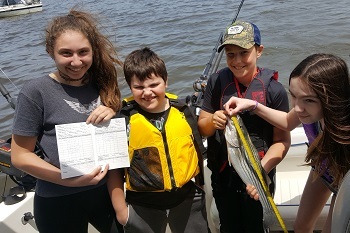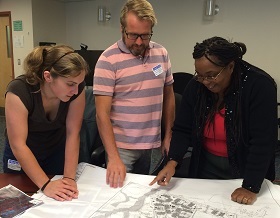Vital Volunteers
 Volunteers and partners are key to the collaborative work of protecting and restoring the Hudson and its watershed. Whether counting eels, planting trees along streams, helping amphibians cross roads, recording striped bass catches, or creating a list of rare plants and animals, community science volunteers increase our understanding of New York's wildlife and natural resources. We couldn't do our work without you. Thank you! Volunteers and partners are key to the collaborative work of protecting and restoring the Hudson and its watershed. Whether counting eels, planting trees along streams, helping amphibians cross roads, recording striped bass catches, or creating a list of rare plants and animals, community science volunteers increase our understanding of New York's wildlife and natural resources. We couldn't do our work without you. Thank you!
Hudson River Estuary Trees for Tribs
Watershed groups, conservation commissions, scouts, and many other people help plant native trees, grasses, and shrubs along tributary streams to reduce erosion and improve water quality. This year, 325 volunteers throughout the spring and fall planted 4,051 native trees.
American Eel Research Project
 From March through May this year, more than 1,000 trained volunteers from community groups and local schools checked 12-foot “fyke” nets to catch, count, and release tiny “glass eels”— juvenile American eels-- on their migration from ocean to estuary to stream. The project provides crucial information on the strength and timing of this migration and connects a wide diversity of people to their environment. Citizen scientists counted more than 240,000 juvenile American eels at 14 tributary sites this year! From March through May this year, more than 1,000 trained volunteers from community groups and local schools checked 12-foot “fyke” nets to catch, count, and release tiny “glass eels”— juvenile American eels-- on their migration from ocean to estuary to stream. The project provides crucial information on the strength and timing of this migration and connects a wide diversity of people to their environment. Citizen scientists counted more than 240,000 juvenile American eels at 14 tributary sites this year!
Amphibian Migrations and Road Crossings
 This year, 127 trained community members helped at least 2,603 salamanders, frogs, and toads to safely cross Hudson Valley roads on their journeys to woodland pools to breed. Woodland pools and forests are mostly unprotected, and as a result, amphibian habitat is vulnerable. Volunteer efforts to document migrations and share information brings awareness to the importance of habitat connections and increases our understanding of migrations in the Hudson Valley. This year, 127 trained community members helped at least 2,603 salamanders, frogs, and toads to safely cross Hudson Valley roads on their journeys to woodland pools to breed. Woodland pools and forests are mostly unprotected, and as a result, amphibian habitat is vulnerable. Volunteer efforts to document migrations and share information brings awareness to the importance of habitat connections and increases our understanding of migrations in the Hudson Valley.
Hudson River Cooperative Anglers
 Hudson River anglers share their striped bass fishing trip information to help biologists understand and manage the Hudson’s recreational striped bass fishery. Whether they catch-and-release or take home a keeper, anglers fill out a logbook to record general location, time, gear used, and what was caught, returning the logbook when they are done fishing for the season. This year, anglers recorded catching and releasing 3,200 stripers. Hudson River anglers share their striped bass fishing trip information to help biologists understand and manage the Hudson’s recreational striped bass fishery. Whether they catch-and-release or take home a keeper, anglers fill out a logbook to record general location, time, gear used, and what was caught, returning the logbook when they are done fishing for the season. This year, anglers recorded catching and releasing 3,200 stripers.
Conservation and Land Use
 DEC's Estuary Program helps communities adopt plans and policies that conserve priority lands and waters that benefit people and the estuary. Throughout the year, members of land use boards, conservation commissions, and municipal councils take part in a variety of training events and field workshops to learn to identify and protect natural resources such as large forests, tidal wetlands, and rare species that are locally and regionally important. More than 600 of these volunteers participated in conservation education this year. Considering natural resources early in the planning process benefits communities and contributes to the long-term protection of our natural heritage. DEC's Estuary Program helps communities adopt plans and policies that conserve priority lands and waters that benefit people and the estuary. Throughout the year, members of land use boards, conservation commissions, and municipal councils take part in a variety of training events and field workshops to learn to identify and protect natural resources such as large forests, tidal wetlands, and rare species that are locally and regionally important. More than 600 of these volunteers participated in conservation education this year. Considering natural resources early in the planning process benefits communities and contributes to the long-term protection of our natural heritage.
|


 Volunteers and partners are key to the collaborative work of protecting and restoring the Hudson and its watershed. Whether counting eels, planting trees along streams, helping amphibians cross roads, recording striped bass catches, or creating a list of rare plants and animals, community science volunteers increase our understanding of New York's wildlife and natural resources. We couldn't do our work without you. Thank you!
Volunteers and partners are key to the collaborative work of protecting and restoring the Hudson and its watershed. Whether counting eels, planting trees along streams, helping amphibians cross roads, recording striped bass catches, or creating a list of rare plants and animals, community science volunteers increase our understanding of New York's wildlife and natural resources. We couldn't do our work without you. Thank you! From March through May this year, more than 1,000 trained volunteers from community groups and local schools checked 12-foot “fyke” nets to catch, count, and release tiny “glass eels”— juvenile American eels-- on their migration from ocean to estuary to stream. The project provides crucial information on the strength and timing of this migration and connects a wide diversity of people to their environment. Citizen scientists counted more than 240,000 juvenile American eels at 14 tributary sites this year!
From March through May this year, more than 1,000 trained volunteers from community groups and local schools checked 12-foot “fyke” nets to catch, count, and release tiny “glass eels”— juvenile American eels-- on their migration from ocean to estuary to stream. The project provides crucial information on the strength and timing of this migration and connects a wide diversity of people to their environment. Citizen scientists counted more than 240,000 juvenile American eels at 14 tributary sites this year!  This year, 127 trained community members helped at least 2,603 salamanders, frogs, and toads to safely cross Hudson Valley roads on their journeys to woodland pools to breed. Woodland pools and forests are mostly unprotected, and as a result, amphibian habitat is vulnerable. Volunteer efforts to document migrations and share information brings awareness to the importance of habitat connections and increases our understanding of migrations in the Hudson Valley.
This year, 127 trained community members helped at least 2,603 salamanders, frogs, and toads to safely cross Hudson Valley roads on their journeys to woodland pools to breed. Woodland pools and forests are mostly unprotected, and as a result, amphibian habitat is vulnerable. Volunteer efforts to document migrations and share information brings awareness to the importance of habitat connections and increases our understanding of migrations in the Hudson Valley. Hudson River anglers share their striped bass fishing trip information to help biologists understand and manage the Hudson’s recreational striped bass fishery. Whether they catch-and-release or take home a keeper, anglers fill out a logbook to record general location, time, gear used, and what was caught, returning the logbook when they are done fishing for the season. This year, anglers recorded catching and releasing 3,200 stripers.
Hudson River anglers share their striped bass fishing trip information to help biologists understand and manage the Hudson’s recreational striped bass fishery. Whether they catch-and-release or take home a keeper, anglers fill out a logbook to record general location, time, gear used, and what was caught, returning the logbook when they are done fishing for the season. This year, anglers recorded catching and releasing 3,200 stripers. DEC's Estuary Program helps communities adopt plans and policies that conserve priority lands and waters that benefit people and the estuary. Throughout the year, members of land use boards, conservation commissions, and municipal councils take part in a variety of training events and field workshops to learn to identify and protect natural resources such as large forests, tidal wetlands, and rare species that are locally and regionally important. More than 600 of these volunteers participated in conservation education this year. Considering natural resources early in the planning process benefits communities and contributes to the long-term protection of our natural heritage.
DEC's Estuary Program helps communities adopt plans and policies that conserve priority lands and waters that benefit people and the estuary. Throughout the year, members of land use boards, conservation commissions, and municipal councils take part in a variety of training events and field workshops to learn to identify and protect natural resources such as large forests, tidal wetlands, and rare species that are locally and regionally important. More than 600 of these volunteers participated in conservation education this year. Considering natural resources early in the planning process benefits communities and contributes to the long-term protection of our natural heritage.